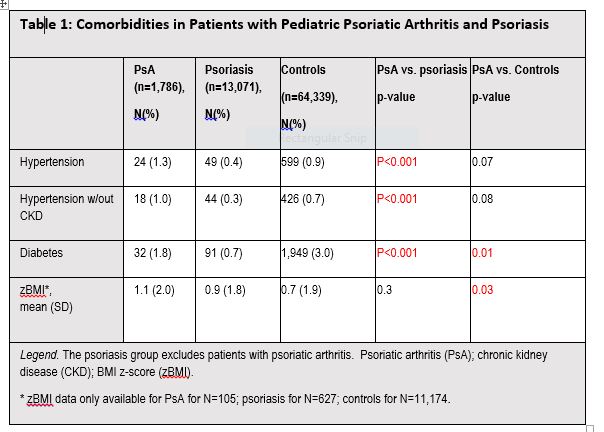Session Information
Session Type: ACR Poster Session A
Session Time: 9:00AM-11:00AM
Background/Purpose: In adults, psoriatic arthritis (PsA) is associated with an increased prevalence of obesity, hypertension, and diabetes. It is not yet known if pediatric patients with PsA also have a higher prevalence of these comorbidities. We evaluated the association of obesity, hypertension, and diabetes with PsA and psoriasis in children.
Methods: We conducted a cross-sectional study of children with PsA and psoriasis enrolled in The Health Improvement Network (THIN) database between 1994 and 2013. All psoriasis and PsA cases in the cohort had ≥ 1 READ code for psoriasis, or psoriasis and arthritis, respectively. The index date was defined as the first READ code entry for psoriasis or PsA. Controls were matched on age, sex, and practice at a 5:1 ratio. Prevalence of hypertension, diabetes, and obesity were calculated among patients in these groups. Hypertension and diabetes were identified using ≥ 1 READ code for these diagnoses. Age- and sex-specific z-scores for BMI (zBMI) were calculated. Differences in demographic and clinical characteristics were assessed using the t-test and Wilcoxon rank sum test, as appropriate.
Results: 6366, 1786, and 13351 children were identified as having juvenile arthritis (excluding PsA), PsA, and psoriasis, respectively. Among children with psoriasis, 280 (2.1%) had PsA. The mean age at PsA diagnosis was 7.7 (SD 4.5) years and psoriasis diagnosis was 9.8 (SD 4.0) years. 62.4% of the PsA, 56.7% of the psoriasis, and 56.5% of the controls were female. Table 1 summarizes characteristics of each patient population at the time of data collection. PsA patients were significantly more likely to have hypertension and diabetes than patients with psoriasis, but did not have a higher prevalence of hypertension and had a lower prevalence of diabetes compared to controls. zBMI was significantly higher in PsA compared to controls (1.1 vs 0.07, p-value 0.03) and psoriasis compared to controls (0.9 vs 0.07, p-value 0.01), but not significantly different between children with PsA and psoriasis (p-value 0.3).
Conclusion: PsA was found to be associated with an increased prevalence of hypertension and diabetes compared to patients with psoriasis, but not compared to healthy controls. Children with PsA and psoriasis also had a significantly higher mean zBMI compared to healthy controls.
To cite this abstract in AMA style:
Manos C, Xiao R, Ogdie A, Brandon T, Weiss PF. Comorbidities Associated with Pediatric Psoriatic Arthritis [abstract]. Arthritis Rheumatol. 2016; 68 (suppl 10). https://acrabstracts.org/abstract/comorbidities-associated-with-pediatric-psoriatic-arthritis/. Accessed .« Back to 2016 ACR/ARHP Annual Meeting
ACR Meeting Abstracts - https://acrabstracts.org/abstract/comorbidities-associated-with-pediatric-psoriatic-arthritis/

